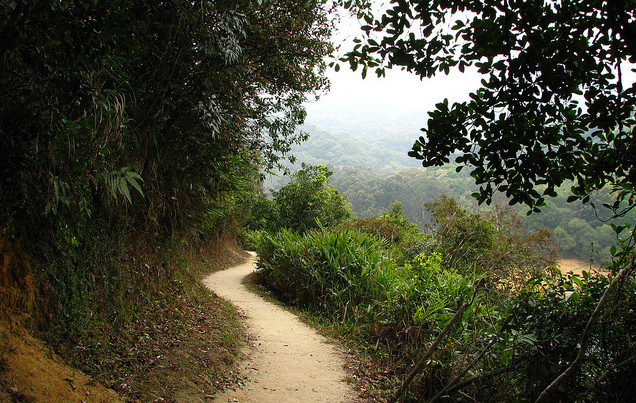

As we trekked up a steep ridge covered in late season grass, the slope gently dropped off on either side. To my right, the rolling green hills were expansive, filling the horizon with a panorama of undisturbed nature. To my left, an easy bluff eventually gave way to a drop of approximately 200 feet (60 m), ending on a sandy beach.
Lazy blue waves broke mildly against the dark, jagged forms of age-old rocks. Farther out, fishing boats and sampans sailed along the point where sky and earth meet, silently going about their business, as they have since time immemorial.
A warm wind blew across the soft peak, and with the exception of my mates, I was alone, in a peaceful world, recovering from the stresses of modern society. Just a few miles away lay the hyper-modern center of Hong Kong, with its busy financial district and high-rise bank buildings.
Most visitors only get to know Hong Kong as a shopping paradise, famous for fine dining and luxury accommodations. But the former British crown colony that reverted to Chinese sovereignty in 1997 is also a tropical island, covered in green peaks and surrounded by a stunning ocean.
Sailing, ocean kayaking, trekking and hiking, paddling, running and cycling are just a few of the active-vacation options available here. The island offers excellent alternatives for those who seek adventure without sacrificing comfort.
Imagine waking up in a plush hotel, driving 40 minutes to a rock climbing venue, then spending an evening at the theater followed by a gourmet dinner and topped off by dancing in a fancy night club. You could spend the next day horseback riding in the foothills and your evening sailing on Hong Kong Bay.
There are an astonishing number of sport activities that are available for little or no money. For my particular trekking adventure, I hooked up with The Hong Kong Trampers, a club with no administration, no applications and no membership forms. Best of all, the club has no fees.
All their walks are led by volunteers, are planned one week in advance and are posted on The Trampers’ website. There you will also find out about times and meeting points, usually a subway station, from where you will head out to the hills together.
The Hong Kong region is made up of Hong Kong Island, the Kowloon Peninsula and the New Territories, a mountainous mainland area adjoining Kowloon, and approximately 230 outlying islands. The capital, on the northwest shore of Hong Kong Island, is officially named Victoria, but it is commonly called Hong Kong. Except for the northern lowlands, the area is hilly to mountainous, with steep slopes.
The highest peak is Tai Mo Shan, at 3,143 feet (958 m). With a population of 6.9 million people crammed into a space of only approximately 400 square miles (1,042 km²), Hong Kong has one of the highest population densities in the world.
For locals, a trip to the hills is a good way to get some relief from the constant hustle of life in the economic tiger. On top of Tai Mo Shan, with a gentle mountain breeze cooling your skin, you will feel free as a bird.
Apart from the breathtaking scenery, trekking in Hong Kong can be a great fitness activity, as well as a way of making friends. The day that I met with The Trampers, we were hiking Yung Shue O to Hoi Ha, near Sai Kung Tow, in the New Territories.
Our group was made up of 15 people, ranging in age from eight to 44. On this particular weekend, the regulars were discussing the Oxfam Trailwalker, a 62-mile (100 km) walking race that some of them had just completed. Others were training for the upcoming Hong Kong Marathon, while some of us had no hiking experience at all.
A group of friendly young women who worked in one of Hong Kong’s many banks confessed that this was their first time exercising in their entire lives. And, while they needed a bit of help and encouragement to complete the 7.4-mile (12 km) course, they all made it.
The trails in Hong Kong are well mapped and marked, with different degrees of difficulty readily available, so, it is easy to find a route and a distance that fits your level of physical fitness. Our trek began with a 40-minute climb up Jacob’s Ladder, a paved staircase built into the side of the mountain. It was extremely demanding, but hikers were free to stop, drink water or rest when needed.
Once the stairs were behind us, the way became much easier. At times the trail took us along a ridge, with a beautiful view of valleys below. Then we walked through the forest, under a canopy of green. We crossed streams, hopping from stone to stone, and waded through waist-high grass on top of some peaks.
When I got to the top, I was completely out of breath and emptied an entire water bottle down my parched throat. Francis, our leader, was probably the oldest and the fittest of group; he had already run to the top and back down several times, to check on stragglers. He assured me that, although I felt we had just climbed to the sun and would melt, in actuality, we had only ascended 1,640 feet (500 m).
By the time we made our final descent, we had gotten quite some exercise, made some new friends, exchanged phone numbers and most importantly, we had seen a side of Hong Kong most visitors would never know.
If You Go
The Hong Kong Trampers
www.hktrampers.com
Hong Kong Tourism Board
www.discoverhongkong.com
- Fiddle, Flutes & Pubs: A Musical Journey Through Northern Ireland & County Donegal - July 14, 2025
- Tokyo vs. Osaka: The Ultimate Face-Off for First-Time Visitors to Japan - July 14, 2025
- When Is the Best Time to Visit Iceland? Find Your Perfect Month for Budget, Weather, and Activities - July 14, 2025
